THIS IS WHERE MORTALS BECOME SUPERHUMAN
In a kitchen not much larger than a broom closet, performance cooks Kelsey Trent ’15 and Anthony DiCicco ’14 are prepping their stations. They are in Phoenix, at EXOS’ flagship 31,000-square-foot facility, which offers personalized coaching, physical therapy, dietary consultation and other services for elite athletes and weekend warriors. Their clientele includes the World Cup–winning German soccer team, Special Operations Commandos, NFL players, UFC fighters and Olympians. EXOS, which calls itself a human performance company, has also run coaching programs for such corporate clients as Adidas, Porsche, Tesla, the Mayo Clinic and Google.
It boasts more than a dozen satellite facilities around the country, with programs operating in more than 400 locations on six continents. Client stays average two to six weeks, with their health tracked on a specialized software program that constructs a customized fitness and wellness program with dietary information and other performance metrics. The physical therapy clinic evaluates mechanicals such as inefficiencies in movement, sometimes uncovering injuries someone didn’t know existed. In the 10,000-square-foot gym, where the motto is “every day is game day,” hip-hop is the soundtrack as guys stretch out on foam rollers. Outside, players run hurdles and do plyometrics as their EXOS coach yells, “Your glutes should be fired up!”
According to Executive Performance Chef Karen Bedel, the majority of chefs who have come through that 15x15-square-foot kitchen are either JWU interns or alumni. “They understand the nutrition component,” she says. “I don’t have to explain the meal builder to them. ESHA (nutrition labeling software) is not a tool some other interns are familiar with.”
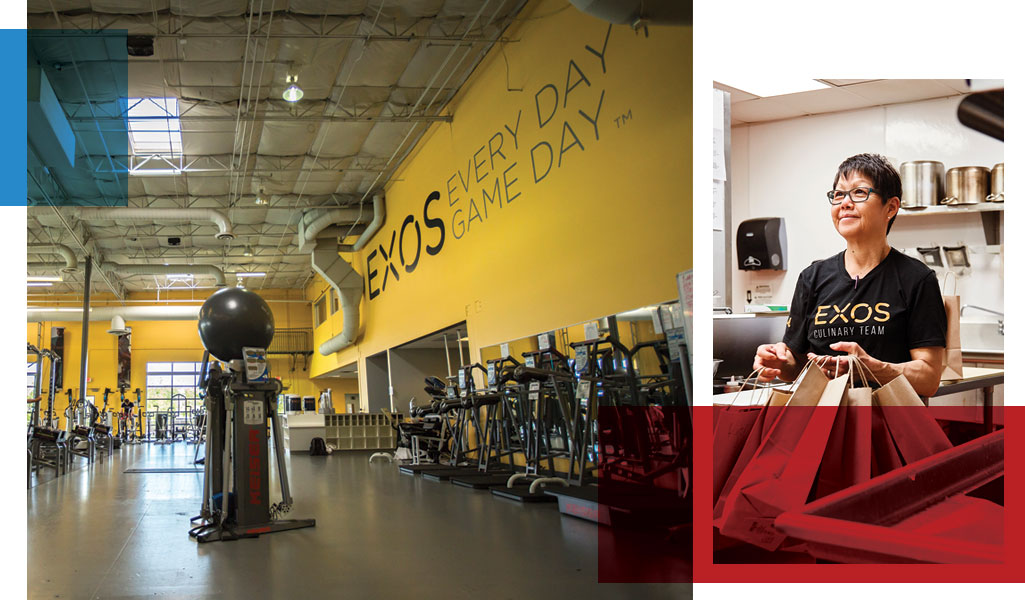
Beyond the kitchen are dining tables and the lounge area with sports television, a Ping-Pong table and a wall decorated with pro-team jerseys. This week, the majority of clients are college combine picks who are prospective NFL drafts. Men the size of redwoods approach with a meal ticket that specifies their choice of protein, starch and grains for lunch. Their body composition has already been tested with ultrasound; based on those results and myriad other factors, staff create a meal builder with a total calorie goal and proper portioning. Bedel checks each lunch ticket against the meal builder so there is no cheating; someone might get half a banana, for example, but no berries.
Nearly 40 men are tuning up for the combine, and each player’s meal builder might change four or five times during his stay. Generally, kitchen staff will see a difference in athletes within a couple of weeks. As the employees say, “You can’t out-train a bad diet.” According to EXOS statistics, a defensive end at the combine who can run the 40-yard dash in 4.7 seconds will make about $1.2 million more on average than a player who does it in 4.8 seconds.
DiCiccio, who studied culinary nutrition, aims to be a chef-dietitian, ideally for a professional sports team. A leg injury that left him hospitalized for a week piqued his interest in how diet can support healing. “Nutrition is about education,” says DiCiccio, who sometimes take athletes on a field trip to the grocery store. “A lot of it confuses people, so it’s great if you can make them self-sufficient.”
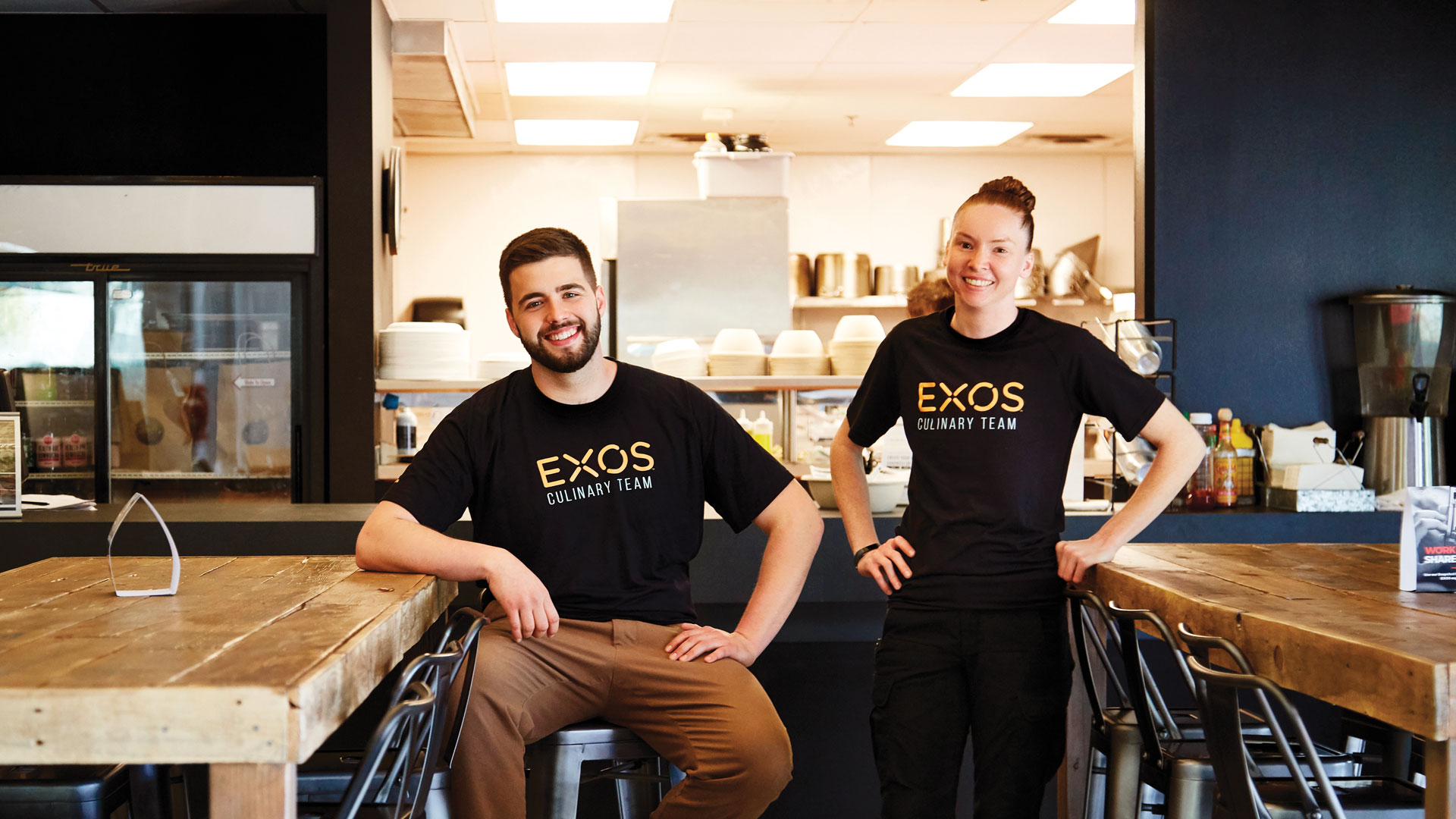
The largest redwood, who stands at 365 pounds, is supposed to shed 15 pounds. His low(er) carb diet incorporates cauliflower rice and tortillas, which are tastier than they sound. It might seem awkward for the 5’9” Trent to tell a 6’4” football player he can’t have any peanut butter, but she says linemen reach over to hug her, others ask for recipes and baseball players slip her spring training tickets. “A lot of the athletes have dietary restrictions, and I have been in charge of the problem children,” says Trent, who studied culinary nutrition and plans to return to school to become a chef–dietitian. “I develop a rapport and ask them questions. Rather than telling athletes what they can’t eat, I say, ‘Here are the 12 things you can eat.’ ”
RATHER THAN TELLING ATHLETES WHAT THEY CAN’T EAT, I SAY, ‘HERE ARE THE 12 THINGS YOU CAN EAT.’Kelsey Trent ’15
FOR THOSE OF US NOT VAULTING FOR THE OLYMPICS, there are small-scale alternatives as purveyors respond to an increasing demand for healing food. For example, imagine sitting in a fast-casual restaurant in London. Your knee is pinging after exploring Trafalgar Square as you’re eyeing an “Absolutely Radishing” salad with hummus and quinoa. But will those ingredients quell inflammation? Luckily, Squirrel (the London restaurant is so named because its treehouse atmosphere is a place where “even a squirrel might feel at home”) has an on-site nutritionist who can steer you to the antiinflammatory ginger rice bowl. They guide patrons toward particular foods that are best for gut health, immunity, cholesterol, fatigue and even depression.
Is Squirrel a harbinger of the future? As our aging population swells — along with accompanying healthcare costs — food remains the best medicine: Diet is the leading cause of preventable death and disease in the United States. DNA food discovery — with personalized nutrition testing and services such as Habit, Fitnessgenes and Geno Palate — is a nascent trend. Habit, for example, tests for biomarkers and genetic variants using blood and DNA samples from a customer, then generates a personalized report about how their body responds to food, offering a “nutrition blueprint.” The company then pairs customers with a nutrition coach and offers customized meals containing their ideal ratio of carbs, fats and protein.
According to market research firms, the global sports nutrition market is forecast to grow at an average of 8.6 percent per year to reach a total of $39 billion by 2020. The timing is right, as Johnson & Wales’ FOCUS 2022 strategic plan includes the establishment of a College of Food Innovation & Technology (CFIT). In 1999, the university pioneered a culinary nutrition program that would bridge the worlds of dietetics and culinary arts — teach chefs to be nutritionists, essentially. With CFIT, Johnson & Wales will explore food systems in their economic, cultural and political contexts, and analyze the impact food has on people, industries and the world. It will investigate the intersection of food with everyday life: product development and design, safety, sustainability, production, distribution, policy, medicine, business, entertainment, economics, nutrition, science, hunger and habits. The end goal will be to develop innovative solutions to real-world problems.
“The nutrition field (especially sports dietetics) is very fluid and dynamic,” says Denver Campus Associate Instructor Adam Sacks. “There are potentially heavy consequences for the consumer and industry if the information disseminated is inaccurate or outdated. Therefore, we need our students to be critical-thinking culinarians who are smart and gritty, skilled and impassioned. And finally, our students need to be advocates of truth and facts, not fiction.”
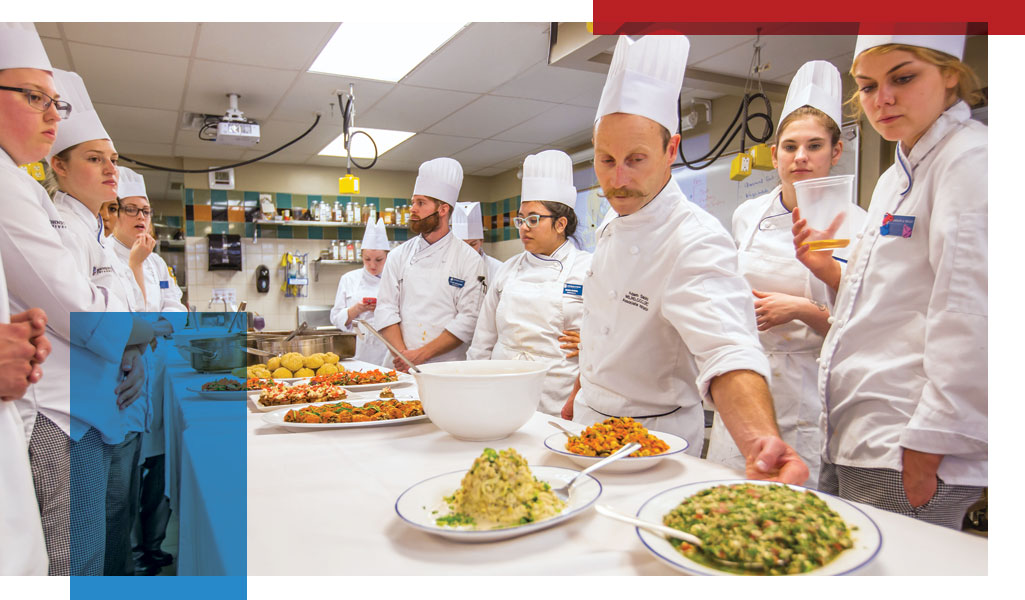
In the lab, Sacks examines an athlete’s metabolism and specificity of goals before he and his students create a personalized menu. “We’re not just assigning food or menus to the athlete,” he says. “We are creating opportunities for them to optimize their training and physiological potential for sport and exercise. It’s funny to think that when I was learning my trade, there were a handful of energy bars and sports foods representing the industry. Now there are entire aisles in grocery stores devoted exclusively to enhancement: more muscle, more energy, more weight loss, more regularity. It’s quite remarkable and silly to think that our students have to hand-hold the consumer or athlete to navigate these aisles of energy bars and sports drinks.”
When Sacks served as executive chef for the U.S. Ski and Snowboard team at the 2018 Winter Olympics, he brought a handful of former students (and a current one) to assist him in South Korea. The instructor admits to a ping of pride when his team wins (he also served as executive chef for the U.S. Track & Field training camp at the 2008 Olympics in Beijing). “I can’t guarantee gold,” he says. “I just promise I won’t undermine their performance with the wrong food.” Fortunately, Sacks is the breed who thrives on a challenge, which included cooking the team’s quinoa oatmeal in a wok pan and operating a kitchen inside a retrofitted ski shop.
“Many of my students are creating their own job descriptions and forcing the industry to re-evaluate traditional roles to make room for our cutting-edge students of the future.”
One of the grads he brought — who chose JWU for Sacks’ mentorship — was Brett Eisen ’12, who runs his own chef business in California. Previously, Eisen was the executive chef and nutritionist for the Sacramento Kings basketball team; he also traveled to the 2016 Olympics in Rio de Janeiro as performance chef for the U.S. Women’s Soccer team. He owns Fuel Good, which helps postretirement athletes maintain a healthy lifestyle through education, meal planning, healthy cooking and other personalized services.
“I realized at a young age that I was this white Jewish guy who needed as much help as possible to make the starting lineup in basketball,” Eisen has said. “I knew if I could better myself through healthier eating, I would do better in sports. I also wanted to travel, work with athletes, and implement real food and nutrition — in a nutshell, live a healthier lifestyle.”
THE TRAINING TABLE
Like Sacks, Providence Campus Associate Professor Jonathan Poyourow ’03, a former military and hospital dietitian, specializes in culinary nutrition. He also teaches a performance cuisine class, where students are charged with designing meals and menus for different types of athletes. The group uses their knowledge of nutrition, biochemistry, anatomy and physiology to develop individual assessments and menus for specific disciplines.
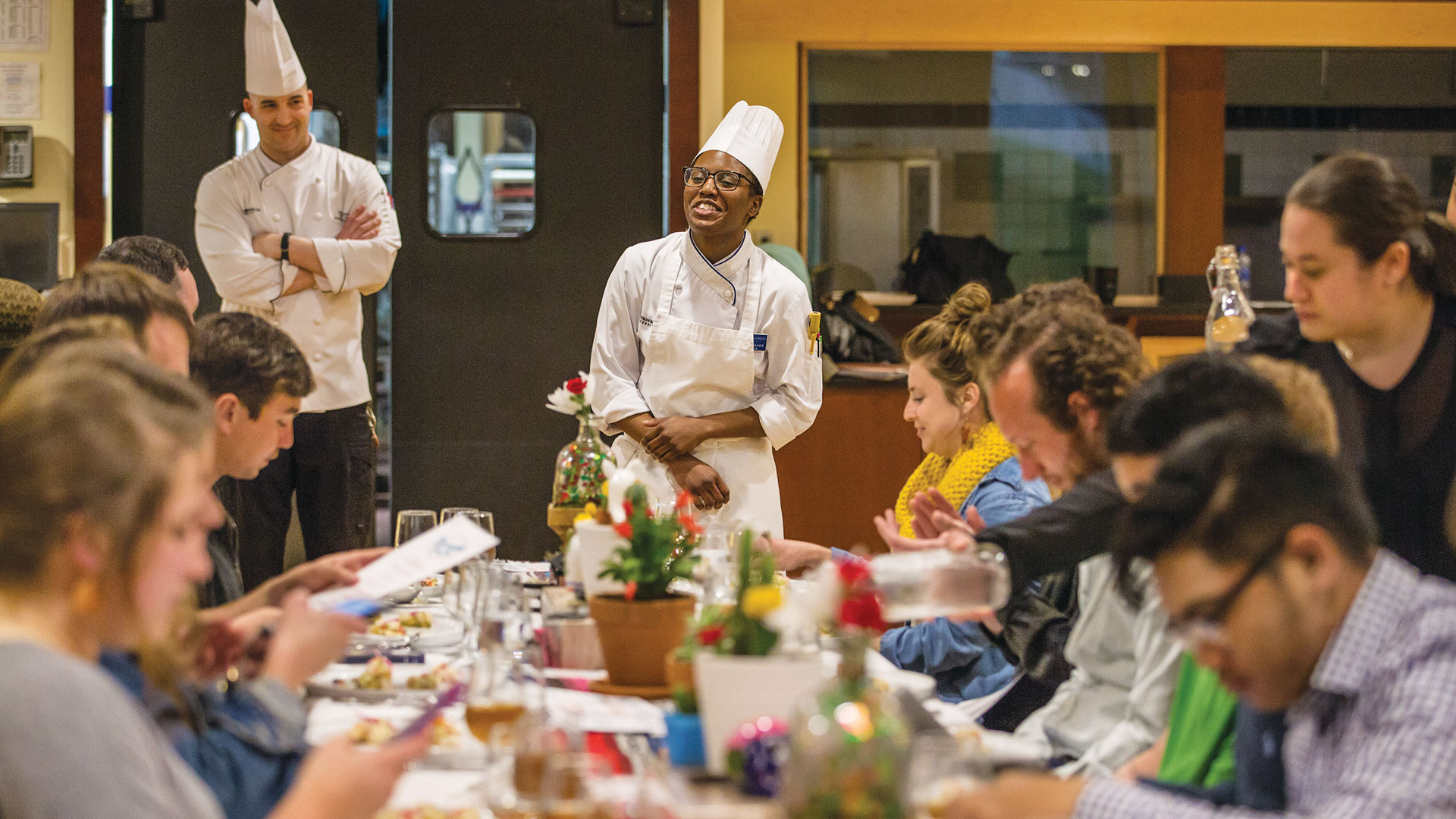
Last spring, his class had nine weeks to create recipes for the JWU men’s tennis team. Tonight is the training table presentation (the class chose elevated Mexican street food). They used mathematical formulas to calculate how many calories were burned during practice and entered the height and weight of each player into a macronutrient calculator. The result? They gleaned exactly how many diabetic exchanges of starch, carbohydrates, protein, veggie, fat and sugar are needed.
Sous Chef Amanda Quille ’19 says their research yielded the significance of carbohydrate drinks for tennis players, so they serve up a peach iced tea version of Gatorade and a mango raspberry mojito.
“If you don’t consume a sports drink right after a match, your performance — coordination, speed and skills — declines by approximately 40 percent,” she notes. “If it was a multi-match, they’d consume a sports drink throughout the meal.”
Some of these students are also taking Associate Professor Paula Figoni’s senior-level Product Research and Development class, which teaches them to create those energy bars and other products Sacks and Poyourow ask students to deconstruct. The class creates, test-markets and develops a market-ready food product in 11 weeks. “It’s a big challenge,” notes Figoni, a food scientist who began her career as a product developer for Pillsbury. “They’re testing these products the same way they would out in the industry.” Figoni’s class culminates in a public taste test where each group unveils its marketready product to a select group of students, instructors and visitors.
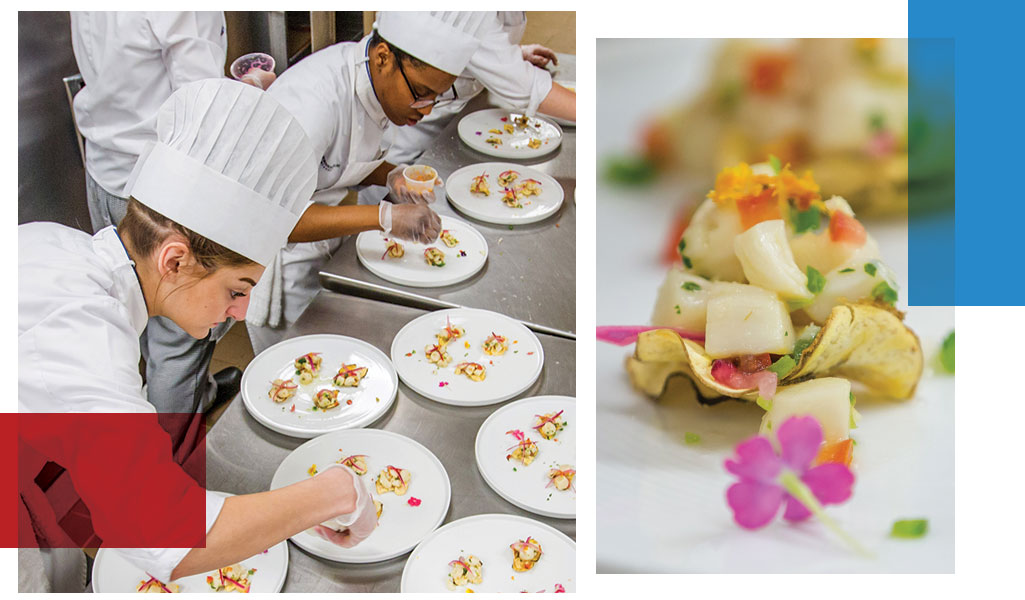
Her students, along with the others, should be able to carve their niche in the job market. “We’re graduating folks with multiple skill sets, which allows them to design their own careers,” says Sacks. “Many of my students are creating their own job descriptions and forcing the industry to re-evaluate traditional roles to make room for our cutting-edge students of the future.”